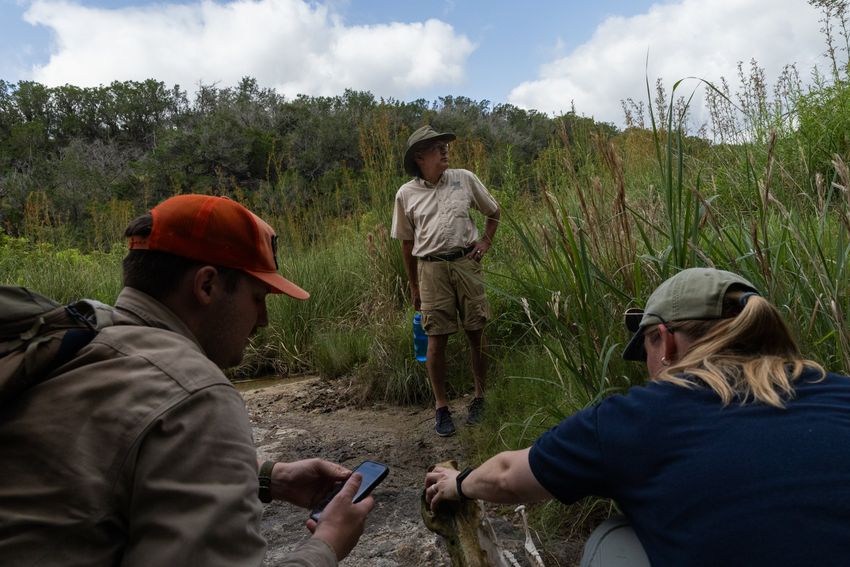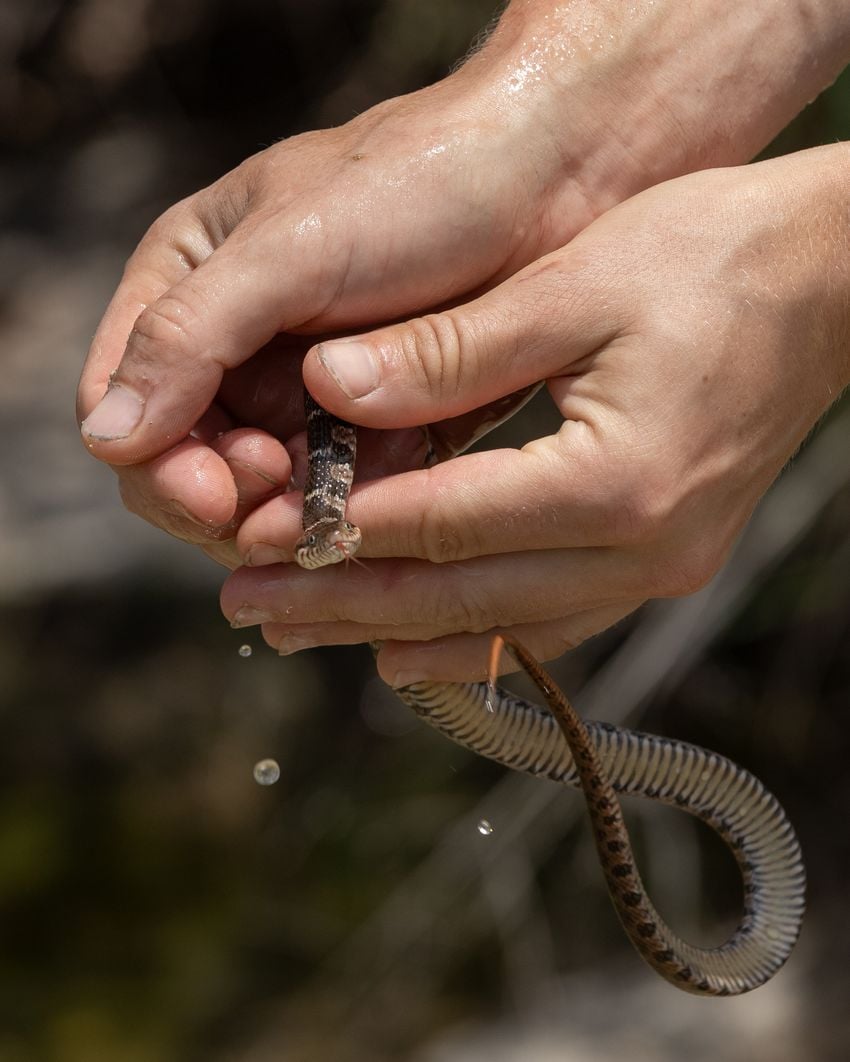
Texas buys land for new state parks that will be developed using $1 billion voter-approved fund
Sign up for The Brief, The Texas Tribune’s daily newsletter that keeps readers up to speed on the most essential Texas news.
LAMPASAS — On a blistering June morning, Andy Sipocz brushes his fingers through the thick, sawgrass fronds rising higher than his head beside a creek in the Texas Hill Country.
Around him, rocky limestone lines Yancey Creek, streaked in subtle reds and browns — evidence of millennia of mineral deposits and weathering.
Sipocz, a natural resources coordinator and biologist with the Texas Parks and Wildlife Department, is one of more than three dozen staffers gathered here to begin laying the groundwork for what will one day be Texas’ newest state park — about a two hour drive northwest of Austin.
Wearing cargo shorts and pants, hiking boots, and sun-brimmed hats, the TPWD team winds its way down a steep hill — no trail in sight. That’s the point. They're here to determine where the trails should be. Today’s mission: conduct early-stage natural resource surveys and habitat assessments to support the park’s future design.
“Like any good business, you need to know what you have before you start,” Sipocz, who has been with TPWD for 35 years, said. “You can't make good plans until you know what it is you've got.”
After voters approved the Centennial Parks Conservation Fund, a $1 billion investment passed by lawmakers in 2023, Texas began a new era of public land acquisition and park development. The fund allows the parks department to expand access to natural spaces across the state, while preserving native ecosystems and cultural landmarks.
That growth is especially significant after a controversial loss in 2023 of Fairfield Lake State Park, a 1,800-acre site about 100 miles south of Dallas. The park closed after the private power company that leased the parkland to the state at no cost chose to sell it. The site was later purchased by a private developer to build a luxury housing project.
Fairfield sat on leased land. Today, 17 parks sit on leased land. The closure sparked widespread outcry and galvanized support for state leaders to buy more parkland so there won’t be a repeat of the Fairfield debacle.
This site is protected by reCAPTCHA and the Google Privacy Policy and Terms of Service apply.
According to a 2022 report by Environment Texas, Texas lags behind most others states in state parkland: The state ranks 35th in the nation for state park acreage per capita, with about 636,000 acres of parkland for a population of over 29 million as of 2019. The report suggests that Texas needs to add 1.4 million acres of state parks by 2030 to meet the needs of its residents.
With the new voter-approved funding, Texas is poised for a historic expansion of its 88-park system. Among the most recent additions to the state park system are:
- A 1,100-acre acquisition in Lampasas and Burnet Counties, including 1.5 miles of Yancey Creek.
- A 2,020-acre acquisition in Burnet County along the Colorado River across from Colorado Bend State Park.
- A 3,073-acre expansion to Enchanted Rock State Natural Area in Llano County, which will significantly expand the 1,685-acre park.
The first two acquisitions will create a new Post Oak Ridge State Park. Centennial fund money will be used to develop the new acquisitions.
“This is kind of a new thing for the department,” Sipocz said. “There was a big burst of acquisitions of parks in the '70s and '80s, and there hasn’t been since. That’s what makes this so exciting.”
Two ranches will become new park
At the heart of the planning process is JJ Fleury, the program director for planning and geospatial resources at TPWD. Fleury said Post Oak Ridge State Park, where Yancey Creek flows, is still in the early stages of development. The park was originally two large ranches, Vann River Ranch and Big Springs Ranch. Park staffers identified the parcels and ultimately acquired them as soon as they went on the market. Together the properties cost $47.1 million.
/https://static.texastribune.org/media/files/4acb4a47549135c46453c1bc7affc771/0605%20Post%20Oak%20Ridge%20EG%2042.jpg)
/https://static.texastribune.org/media/files/d8262417fd9a82a6c846cae8c76b464e/0605%20Post%20Oak%20Ridge%20EG%2087.jpg)
Fleury said the park checked a lot of boxes: within the Texas Triangle formed by Houston, San Antonio and Dallas-Fort Worth, varied terrain like sweeping canyons and frontage along the Colorado River. He added that the flatter, less scenic areas of the park could serve as “back of house” zones for wastewater treatment, maintenance, or staff housing.
This site also sits near Colorado Bend State Park. When developed, the more than 3,000-acre new park along Yancey Creek will connect with the greater Colorado Bend ecosystem, which Fleury said will expand conservation efforts at a regional scale.
“One of the exciting things is that landscape scale of conservation, where we're protecting now 10,000 acres,” Fleury said. He also added that the park is filling recreation gaps like cabins and RV camping, which Colorado Bend doesn’t provide.
A “herp search” to catalogue critters
Early that June morning Greg Creacy, a natural resources program director for Texas State Parks, leads a team of biologists, herpetologists and hydrologists through the ecological inventory — walking the land, cataloging species and habitats, and determining what’s rare or sensitive.
The Yancey Creek survey starts with a herp search — short for herpetology — which includes snakes, lizards, frogs and salamanders.
“[That knowledge] informs our plans for how to conserve these systems and these species over the long haul,” Creacy said. “It also informs how we manage the site, how we develop and how the public uses the site recreationally and doesn't negatively impact those resources.”
Staff fan out across the limestone creek bed, squating, lifting rocks and peering into the shadows because according to Sipocz, the biologist, that’s where these creatures like to hide — under rocks where it's cool and moist. For Sipocz, there’s a thrill in every discovery. He jokes and says picking up rocks is addictive and gives him high.
It doesn’t take long before they’re hollering joyfully from opposite banks.
“OMG, look at this!” one yells.
/https://static.texastribune.org/media/files/2fcde9a64d030cd23b9c2530e2fcb87e/0605%20Post%20Oak%20Ridge%20EG%2050.jpg)
/https://static.texastribune.org/media/files/da5e415070e4e6fd52c816e5af8fa454/0605%20Post%20Oak%20Ridge%20EG%2037-2.jpg)
“What have you got?” another replies.
Tadpoles wriggle in shallow pools. A Rio Grande leopard frog attempts to escape with a leap before being gently scooped for identification. A water moccasin slithers through the tall grass — taking Sipocz by surprise.
One team member spots a bright blue collared lizard basking on a sun-warmed rock and picks it up, while another points out a delicate Maidenhair Fern. Someone else finds a tiny skink hiding beneath a loose stone, and a plain-bellied water snake in the creek.
Staffers use the iNaturalist app to log every species they encounter, uploading photos and habitat notes in real time. The data will help TPWD assess the site’s ecological significance and identify sensitive areas in need of protection.

These discoveries guide the placement of trails and facilities — and sometimes determine what can’t go where.
“We might find a flat, buildable area that looks great for a trail,” said Fleury, “but then our resource team comes back and says, ‘Endangered species habitat — move it.’”
Electrofishing in Yancey Creek
Following the herp search, the TPWD team pivots to the fish community. A small team steps into the clear, and at times knee-deep waters of Yancey Creek. Some wear waders; others simply brave the water in soaked clothes.
Using a method called electrofishing, the team led by aquatic biologist Stephen Curtis, temporarily stun fish with a low electrical current — enough to make a human hand tingle uncomfortably, but not dangerous to fish. Every zap from the backpack-mounted electrofisher triggers a sharp beep as fish float to the surface, where they are gently scooped by a net to later be dumped into buckets for identification. The team documents species one by one, sorting and tallying.
/https://static.texastribune.org/media/files/110df66f0cc3c19f73b12cae6290a2f8/0605%20Post%20Oak%20Ridge%20EG%2068.jpg)
/https://static.texastribune.org/media/files/79085e6dbe1ad28ef1c263909e1a9fc8/0605%20Post%20Oak%20Ridge%20EG%2059.jpg)
They found an array of native species including longear sunfish, Western mosquito fish, sand shiners, blacktail shiners with their striking orange fins, and Texas tetra. Buckets quickly filled, especially with the “cuss bugs,” a local nickname for a particularly prickly aquatic insect with small stinging barbs. After they count the fish and scribble its species on a pad, they release them back into the creek.
“That’s a good sign,” said Curtis. “We have a lot of complexity in this stream. We have a variety of habitats for fish to occupy and we want to keep it that way and keep that managed to where we can share this with people in the future.”
Curtis said that sampling fish is about building a deeper understanding of the ecosystem. Fish diversity can reveal how healthy the stream is and how well it's functioning. It will also help them assess how they will need to manage the fish population when this site is open to the public for fishing.
In addition to identifying fish, the team collected water samples and measured how much water is flowing.
Fleury, the park planner, said that once surveys are done, park planners will work closely with resource specialists to steer clear of sensitive areas for species and start figuring out the best spots for things like roads, parking, utilities, buildings, and recreational features — think trails, campsites, and picnic areas.
As they go, the planning team will create some early concept plans to share with the public and get feedback from the public at a series of local and regional public meetings where they can weigh.
The idea is to gauge what kinds of experiences people want — day use, overnight facilities, paddling access, etc. — and test the early concept plans before they’re finalized.
Once a plan takes shape, TPWD moves into design and construction.
“It’s like building a small city,” Fleury said.
With the Centennial parks funding, the timeline is fast. He said that people can expect to have access to Post Oak Ridge State Park, the new park at Yancey Creek, within a year. That could mean guided tours, paddling, birding or limited day use on existing ranch roads. Within 18 months, the goal is to have basic facilities such as trails, parking areas and restrooms. And within four years, a full-fledged state park including day use and overnight recreation, administrative support facilities, utilities, roads and parking.
Back at Yancey Creek, the team wraps up its survey. Some are sunburned, wet or mud-splattered. They’ve logged dozens of species and mapped critical areas for future planning. As they begin the long trek back up the hill, one staffer takes a moment to admire the land, which remains raw and untamed.
/https://static.texastribune.org/media/files/c79eeddf51b45797c18818f339601984/0605%20Post%20Oak%20Ridge%20EG%2092.jpg)
In the near future, this stretch of Texas Hill Country could become a place the public can cherish and explore.
“This is why I got this career,” Sipocz said. “We don't get paid a lot, but… we get paid in sunsets.”
Disclosure: The Texas Parks And Wildlife Department has been a financial supporter of The Texas Tribune, a nonprofit, nonpartisan news organization that is funded in part by donations from members, foundations and corporate sponsors. Financial supporters play no role in the Tribune's journalism. Find a complete list of them here.
🎆 During our Independence Day Sale, save $30 on your TribFest ticket.* Tribune members, students and educators save even more! Act fast — Offer ends at midnight Friday, July 4.
*Discount does not apply to Executive or VIP tickets
TribFest 2025 is presented by JPMorganChase.
Information about the authors
Learn about The Texas Tribune’s policies, including our partnership with The Trust Project to increase transparency in news.
/https://static.texastribune.org/media/profiles/2022_Alejandra_Martinez_2x3.jpeg)
/https://static.texastribune.org/media/profiles/Edison_Wu_1.jpg)